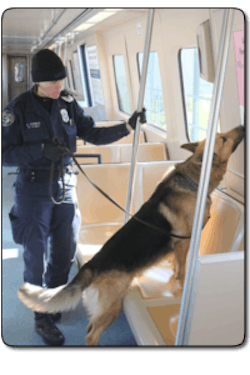Living in a day and age where bombings targeted at the transportation system are a legitimate concern and fear can be hard to believe sometime, the help of 15 furry friends are easing the fear for MARTA. In 1997, MARTA added a canine unit to its transit police force. In 2000 MARTA became the first transit agency in the nation to receive a TSA-certified dog and served as the pilot program for TSA.
Currently the CANINE unit consists of 15 teams, each made up of one dog and one officer. According to Assistant Chief Joseph Dorsey, MARTA gets its dogs from two sources – either the National Explosive Detection Canine Training Center down at Lackland Air Force Base in San Antonio, Texas, which is a 10-week intensive training period, or the Auburn University Canine Detection Training Center in Auburn, Ala., which is a 12-week program.
In 2004, MARTA was the first to receive an Auburn-certified dog in a pilot program. While both TSA-certified and Auburn-certified dogs are explosive detection canines, only the Auburn dogs are people screening dogs, explains Dorsey. “That means they can be used to sniff out suicide bombers,” he says.
“Basically the mission for the canine unit is to detect, deter explosive devices in the system, provide high visibility at high volume stations and provide support to field operations. They are strategically deployed throughout the entire system on a daily basis. They also train daily. They are highly trained and have to continue that training on a daily basis. All of their training is pretty much overseen by TSA,” explains Dorsey.
“It’s working great for MARTA and they do a great job out there. They are highly sought. Anytime anything happens in the region we’re pretty much the first people they call and one of our dogs come and clear the area,” Dorsey says.
The canine units are deployed throughout the whole system at strategic locations, and are used from the start of revenue service and go until the end of service. On any given day, Dorsey says, you might find them on a train car, in a parking lot, at the bus garage, at a station, on the bus, as well as a variety of other places.
“It’s been a very positive effect on our system,” says Dorsey, “and I also think it’s been a very positive effect by deploying them randomly throughout our system on anyone who wants to do any type of harm to the system.”
In addition to protecting the MARTA system, the canine unit will also help out if situations arise in another agency’s jurisdiction, Dorsey says. They have been used on several different occasions to sweep different areas, and have made several trips to the court house. They’ve also been used on presidential details, he says.
Dorsey says the public response has all been positive. The only problem is, when people see the dogs they want to pet them. To help prevent this, each dog wears a vest informing the public that they are working dogs and can’t be pet.
There are currently no plans to expand MARTA’s Explosive Detection K-9 Unit program; however, Dorsey says it is a possibility for the future.
About the Author

